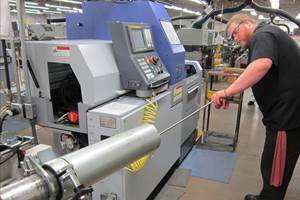Coming to a School Near You
The parents I know who have students in engineering school are giddy about the compensation level that these young people are being offered.
To help solve the skilled labor shortage that we are facing in manufacturing, we have to begin to think and act on a local basis.
Have you visited with your local school administrators recently to get an update on their programs and plans? Are you working closely with the machine trades programs or the Science, Technology, Engineering, Math (STEM) academies at high schools in your area? Have you invited parents, students, educators and administrators to your place of business for an open house? Have you established a mentoring program with a school or developed an internship program with a community college or engineering school?
The more schools that I visit, the more clear it is to me that parents, educators and administrators are not aware of the career opportunities that are available to smart, talented young people today, and that we have a skilled labor shortage in our industry. They are not even aware that the U.S. is still the largest manufacturing economy in the world, and that we make the important things that they use in their daily life, so we have to remind them of that and change some perceptions along the way.
Even when I visit large high schools that already have terrific STEM Academy programs in place, I see a pervasive lack of awareness that young people can earn an Associate Degree at a community college that has an advanced manufacturing technology program in place, they can earn a degree in less time, they can pay for their degree at a fraction of the cost, and they begin a career in a very high paying job in manufacturing sooner. Then, if they choose, they can continue on to a 4-year degree in engineering, and in many cases, have their college paid for through tuition reimbursements.
Parents are only recently realizing that the promise of a college education for all is not as promising as it was in the past. Almost 50 percent of recent college graduates are unemployed and many are living back home with mom and dad while they hold down part-time jobs.
In fact, according to a recent report by the Center for College Affordability and Productivity, some 40 percent of college graduates who are currently employed are in jobs that the Bureau of Labor Statistics (BLS) suggests require less than a 4-year college education. Further, 11 percent of employed college graduates are in occupations requiring more than a high-school diploma, but less than a bachelor’s degree, and 37 percent are in occupations requiring no more than a high-school diploma.
The report goes on to say that not all majors are equal. Engineering and economics graduates typically earn almost double what social work and education graduates earn by the middle of their career. This fact alone makes you wonder why colleges, universities and lending institutions would not support a system that provides preferential treatment in admissions, student loan interest rates and offers to engineering students especially, but that’s another story for another day.
The parents I know who have students in engineering school now or have recently graduated with an engineering degree are giddy about the compensation level that these young people are being offered. We need to get that message to more schools and more parents so the students will get the message, too.
At AMT – The Association For Manufacturing Technology, we’re conducting “Making College Work Night” events at large high school systems, inviting parents and their students to learn more about the option of moving to post-secondary education from a machine trades program or STEM Academy more affordably by way of an advanced manufacturing technology program at a community college in their local area. Some of these high schools either already have or are now working on dual credit agreements where the high school students take classes at a local community college and earn credit while they are still in high school.
We show the community that there are jobs available in our industry, that manufacturing jobs are the highest paying jobs of any industry, and there are alternative ways to qualify for those jobs without going immediately to a 4-year school, and taking on an excess amount of student loan debt.
Going school to school in your local community may be the most effective way to get the word out, change perceptions and begin to resolve the skilled labor shortage in our industry.
Related Content
6 Tips for Training on a Swiss-Type Lathe
There are nuances to training a person to effectively operate a Swiss-type lathe. A shop I visited a while back offers some suggestions.
Read MoreEmerging Leader's Dedication to Education
Instilling confidence throughout a shop floor can do wonders for company morale while increasing productivity.
Read MoreGift a 3D Printer to an Employee?
Some shops have purchased inexpensive polymer 3D printers for their operations. Does it make sense to take this a step further and give (or loan) a sharp young employee one to experiment with at home? This small investment could pay off for your shop in different ways.
Read MoreApplying a Healthy Approach to Employee Investment
Service Center Metals’ on-site health center offers its employees and their families free same-day health care and, in return, the employer is gaining many benefits including a healthier workforce and attracting potential employees.
Read MoreRead Next
Do You Have Single Points of Failure?
Plans need to be in place before a catastrophic event occurs.
Read MoreA Tooling Workshop Worth a Visit
Marubeni Citizen-Cincom’s tooling and accessory workshop offers a chance to learn more about ancillary devices that can boost machining efficiency and capability.
Read More5 Aspects of PMTS I Appreciate
The three-day edition of the 2025 Precision Machining Technology Show kicks off at the start of April. I’ll be there, and here are some reasons why.
Read More







.jpg;maxWidth=300;quality=90)














